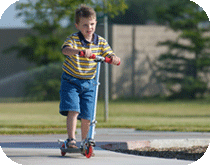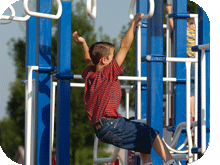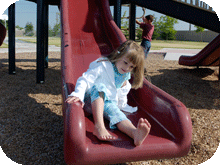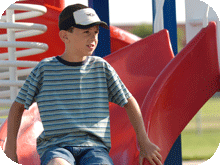
This mailer has been provided as an avenue to disperse information pertinent to public agencies and the landscape architecture profession in hopes of fostering greater understanding and collaboration. Topics address issues that affect the built environment within which we live.
Addressing Vestibular & Proprioceptive Sensory Dysfunction in Recreational Activities
"There are children playing in the streets who could solve some of my top problems in physics, because they have modes of sensory perception that I lost long ago. "(J. Robert Oppenheimer)
When presented with the question, "what senses are used to help you understand the world around you", most of us would respond with the traditional five senses we were taught in elementary school: sight, sound, smell, taste and touch. There are however, two additional sensory systems that we unknowingly take for granted which are extremely important to be completely integrated into any physical activity: the Vestibular and Proprioceptive senses.
The Vestibular Sense
 The vestibular sense is closely related to the other sensory systems of the body and acts as a bridge between sensory information gathered about the surrounding environment and information gathered about one's body. The vestibular sense creates awareness of one's self and one's position in the environment.In general this sensory system informs us of motion and our current orientation (up and down, etc.).
The vestibular sense is closely related to the other sensory systems of the body and acts as a bridge between sensory information gathered about the surrounding environment and information gathered about one's body. The vestibular sense creates awareness of one's self and one's position in the environment.In general this sensory system informs us of motion and our current orientation (up and down, etc.).
The vestibular "sensors" are found within the inner ear and continuously monitor head movements related to angular acceleration and linear acceleration. These sensors then report the head's position and direction of movement to the brain where it is processed and the body is told how to react. Another function of these sensors is to control movement of the eyes to compensate for movement of the head, essentially stabilizing vision. Balance and large motor skills are great examples of roles the vestibular sense performs.2
Most individuals give little thought to the existence of these sensory organs. However, there are many people whose sensory systems are either lacking, impaired or nonfunctional. These individuals do not experience educational and recreational activities in traditional ways, and can easily experience sensory overload or a significant lack of stimulation.2 There are however, design methods that when thoughtfully applied, not only allow these individuals to enjoy recreational spaces but can simultaneously provide the general population with recreational enjoyment as well. A few examples are listed below:
- Provide wayfinding materials within the landscape
- Provide clear, precise visual cues related to circulation and activities
- Provide physical activities with varying levels of required motion (Activities requiring ranges of intense movement to minimal movement)
- Provide activities and equipment that limit movement of the head
- Provide rest areas in close proximity to all active areas. (A retreat from sensory rich environments).
- Provide opportunities for postural security (This may include physical supports such as chairs, tables, and vertical posts. Also included are the inclusion of strong vertical cues or impressions to help with upright orientation and the creation of cozy spots where individuals can escape from the immediate environment)
The Proprioceptive Sense
 The proprioceptive sense, in contrast to the vestibular sense, is entirely related to the position and understanding of an individual's current location. It is the ability to feel, understand and visualize the body and the relationship between its parts. Essentially this is the ability to plan body movements and positioning without the use of vision or touch. A simple illustration of this is the ability to touch the index finger to the nose while blindfolded.1
The proprioceptive sense, in contrast to the vestibular sense, is entirely related to the position and understanding of an individual's current location. It is the ability to feel, understand and visualize the body and the relationship between its parts. Essentially this is the ability to plan body movements and positioning without the use of vision or touch. A simple illustration of this is the ability to touch the index finger to the nose while blindfolded.1
The proprioceptive "sensors" are located throughout the body within the joints and muscles. They send information to the brain related to the stretching and compression of the body which is translated into an overall understanding of the body's location, forces being applied, directional movement and speed. In order for this sensory system to perform correctly a normal range of muscle tone is required. 1
There are however, many people who do not fit into the normal range of muscle tone due to issues such as physical injury or surgery. Old age, disease and health issues such as arthritis, brain injury and poor circulation as well as a insufficiently modulated muscle tone can also limit proprioceptive sensory function. Individuals who suffer from dysfunctional proprioceptive perception may struggle with physical strength, need frequent rest, have poor coordination, apply too much or too little force during activities, seek out activities with strong pressure or stretching and may create postures to help reinforce their understanding of where each body part is.1 There are design methods that, when thoughtfully applied, can allow these individuals to enjoy recreational spaces as well. A few are listed below:
- Provide simple equipment with simple tasks
- Provide clear visual markers in the landscape
- Provide moveable items of varying weights to accommodate users of differing abilities and to promote muscle building activities
- Provide opportunities for stretching and compression activity (Gymnastic bars, trampolines, climbing/tumbling etc.)
- Include swimming pools (Water pressure and buoyancy adds to sensory awareness)
- Provide rest areas in close proximity to all active areas. (A retreat from sensory rich areas)
- Provide physical supports such as chairs, tables, posts and rails to lean against, sit upon and re-gain stability.
These sensory systems are complex and warrant much more thought and research than can be discussed in this article. The suggestions mentioned above are just a few design ideas that can be incorporated into recreational areas, with very little effort or money, as long as they are addressed early in the planning process. Most individuals would probably never notice the subtle differences made in the recreational landscape. These accommodations, however, can mean the world to individuals who deal with difficulties related to the vestibular or proprioceptive sensory systems on a daily basis.
References:
1-David Brown. The Forgotten Sense- Proprioception. DBI Review:July-December 2006. pp. 20-24 San Francisco, CA.
2-David Brown. The Vestibular Sense. DBI Review:June 2007. pp.17-22. San Francisco, CA.
3-Bonnie B. Hebert. Design Guidelines of a Therapeutic Garden for Autistic Children (thesis document). Louisiana State University Agriculture and Mechanical College. May 2003.
4-J. Robert Oppenheimer. (n.d.). BrainyQuote.com. Retrieved October 11, 2010, from BrainyQuote.com Web site: http://www.brainyquote.com/quotes/quotes/j/jrobertop106068.html
The next time you need a Landscape Architect on your project, consider O'Dell Engineering's Landscape Architecture Department.
Services include:
- Park and Playground Design
- Recreational Facility Design
- Site Planning
- Streetscape Design
- Urban Design
- Commercial Design
- 3-D Visualizations
- Graphic Design
- Arborist Consulting
![]()
![]()



Author: Chad Kennedy, Landscape Architect
This informational article provided by O'Dell Engineering - 1165 Scenic Drive, Suite A, Modesto CA 95350
